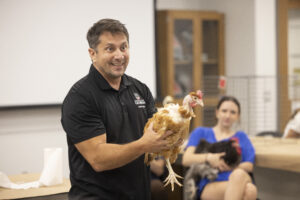Registration and hotel reservations for attendees to PEAK 2025 – powered by the Midwest Poultry Federation – open Wednesday, December 4 at www.midwestpoultry.com.
Show dates are April 8-10, 2025 at the Minneapolis Convention Center in Minneapolis, Minnesota. PEAK is the nation’s largest trade show and convention in North America focused exclusively on the business and food production of poultry. PEAK 2025 offers a variety of education, networking and trade show activities that bring the poultry industry together.
Included in all PEAK registration fees
- Multi-State Poultry Feeding & Health Conference on Tuesday, April 8
- Education tracks for turkeys, egg layers, broilers, and (NEW track) poultry diseases on Tuesday, April 8
- NEW in 2025 – PEAK-Cargill Education Theater, with a variety of topics and speakers running all day Wednesday, April 9 and half-day on April 10
- Business and Leadership Track for leadership and professional development – exact schedule to be announced in early 2025
- PEAK’s Exhibit Hall – open 10am-5pm on Wednesday, April 9 and Thursday (half day), April 10
Don’t forget – PEAK Unhatched is back and will be better than ever!
- PEAK Unhatched: An Evening of Eats and Entertainment takes place opening night at PEAK – Tuesday, April 8 starting at 5:00 pm. at the Minneapolis Convention Center; tickets are $50/person (in advance or $100/person the day of the event) and include a full bar all evening, an abundance of food, and the Bluewater Kings Band, a high energy ensemble that will be epic!
“PEAK 2025 is the ultimate destination for anyone in the poultry industry looking to stay ahead of the curve. With our expanded Education Theater offering up to 30 presentations and a trade show floor showcasing the latest innovations, PEAK is where connections are made, knowledge is shared, and solutions are found,” said Lisa Henning, President of MPF. Henning works for Henning Companies, a long-time exhibitor at the show. “Don’t miss this opportunity to grow your business and your expertise in one powerful event.”
PEAK’s long-time partnering events include:
- Organic Egg Farmers of American Symposium (April 8) – NEW in 2025, you will be able to add a registration ($40/person in advance) for this event via the PEAK registration process – click here for information
- Devenish Nutrition Symposium (April 8 by invitation only) – click here for information
- North Central Avian Disease Conference (April 7-8) – separate registration process or this event; click here for information
Registration fees for PEAK 2025 are as follows:
- Attendee (includes all live production – farmers, processing companies, hatcheries, breeders; government personnel; academic personnel; poultry nonprofit organizations; and spouses of paid registrants) – $50 in advance / $100 at the door
- Supplier (non-exhibiting vendors of the poultry industry) – $400 in advance / $800 at the door
- Students (2-year, 4-year, and technical schools as well as youth accompanying parent/paid adult) – complimentary
Details on all PEAK events, education program, and the list of exhibitors are available at www.midwestpoultry.com. You may also contact MPF with any questions at info@midwestpoultry.com or 763/284-6763.
About the PEAK and MPF
Midwest Poultry Federation (MPF), a 501(c)6 nonprofit organization, was founded in 1971 and held its first convention in Minneapolis in 1972. MPF’s primary purpose is to host an annual convention emphasizing on-farm poultry production. The convention’s goal is to offer cutting-edge information to attendees through a balanced offering of exhibits and educational workshops.
PEAK stands for Profitability, Experience, Advancement and Knowledge – MPF’s promise to attendees is to always provide these four keys to unlocking success for your business.
In 2024, PEAK welcomed nearly 3,300 attendees and exhibitors to its show. All revenue (after expenses are paid) generated by PEAK is given back to MPF’s member state poultry organizations and also donated to various poultry organizations, like the Midwest Poultry Consortium and the National 4-H Poultry and Egg Conference.



















